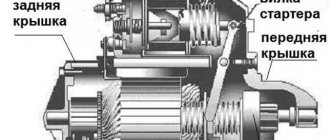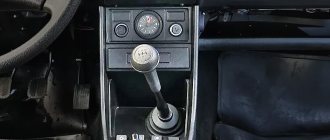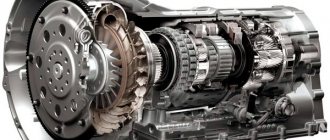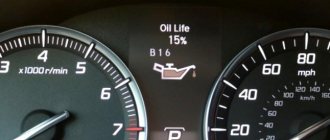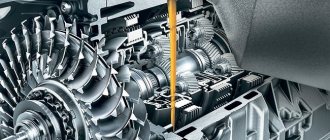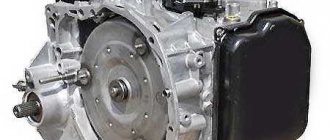How the DSG 6 robotic gearbox works
The box in question is one of the so-called “robots”. In the DSG family of gearboxes, the process of changing the gear ratio is automated, but the box is based on the same classic “mechanics”, supplemented by control units and hydraulic servos. The gearbox gears are switched by synchronizer clutches, but the clutches are driven hydraulically. An electronic unit called “Mechatronic” controls the coordinated operation of the ensemble of box components.
This is what the block looks like when the box is disassembled:
The box unit reads the readings of many sensors:
- rotation speed of the input and output shafts of the DSG box;
- oil pressure in the box and its temperature;
- shift fork positions, etc.
Analyzing this data, the electronics decides to select the desired gearbox mode.
DSG 6 device
DSG 6 (model DQ250) was developed in 2003. At the factory, the box is labeled as VW02 E, a distinctive feature of this box from the 7-speed “older friend”, released three years later, is the so-called “wet clutch”. This means that the gearbox disc packs are constantly immersed in an oil bath and operate under conditions of constant lubrication and cooling. This significantly increases the resource of both the discs themselves and the box as a whole.
Schematic structure of the box:
Main building blocks:
- double clutch box;
- crankcase;
- differential box;
- two rows of gears;
- control unit of the Mechatronic box;
- main gear.
The double clutch transmits torque to the gearbox's rows of gears. The drive disk of the box is connected to the friction clutches and the flywheel by a special hub, which also combines the gears.
The first row of gearboxes operates with odd gears and reverse gear. The second, accordingly, serves the remaining stages of the transmission.
The ECU is located in the box body, in the crankcase.
An equally important element is the electro-hydraulic unit, which carries out all the physical operations of changing gear ratios in the box. Its main components:
- control and solenoid valves of the box;
- multiplexer generating a control signal;
- box distribution spools.
When the driver moves the gearbox selector to one of the positions, the gearbox distributors are activated. Gears are changed using solenoid valves, and the clutch clutches are adjusted by pressure valves. Therefore, these valves can be called the “heart” of the box, and “Mechatronic” - its “brain”. The DQ250 box multiplexer controls the hydraulic cylinders. In DSG 6 there are 8 of these, but a maximum of 4 box valves are activated at the same time. When the multiplexer uses one mode or another, different cylinders are activated, depending on the gear selected on the gearbox.
Typical DSG gearbox selector:
Thus, the DSG 6 box operates on fairly simple shifting algorithms, changing gears cyclically. At one point, two rows of gears are engaged, but the second (currently inactive) is still working, just not being used. If the gearbox changes the gear ratio, the row is engaged without restarting, entering the activity phase. This allows you to reduce the gear shift time literally to a fraction of a second, making the car move smoothly and accurately, without the “thoughtfulness” typical of “slower” gearboxes. And this approach made it possible to give the box the name “preselective”, since the desired gear is always ready for work.
Features of the automatic transmission on the Volkswagen Polo
The Aisin TF-60SN 09G automatic transmission is installed on Polo starting from the fourth generation of the model. It was developed in 2003 by a company from Japan, Aisin, and was linked to VAG automotive equipment by German specialists.
The Volkswagen Polo automatic transmission is still installed on VW, Audi, and Skoda cars.
The DSG-7 robotic gearbox is also a product of cooperation between VAG and another German company LUK. It appeared in 2008 on the concern’s hatchback. The sedan was equipped with it in the 2015 GT sports version. She retained her presence on the sixth generation liftback.
Photo of the Aisin TF-60SN box
Automatic transmission VW Polo
Aisin TF-60SN interacts with power plants whose torque does not exceed 280 Nm. In the VW Polo, it is paired with a 1.6 liter petrol engine. The main component of the unit is the valve body located at the bottom of the gearbox. It was in his address in the early years that complaints were heard about the quality of work. As a result of modernization, the shortcomings were corrected, and currently the automatic transmission on the Volkswagen Polo works flawlessly.
In the first years of the automatic transmission's existence, manufacturers declared that this unit was maintenance-free. However, a large number of breakdowns that occurred due to the inability of the oil to cope with the work for a long time forced VAG to change its decision.
Now, according to the regulations, the ATF must be changed after 80 thousand kilometers.
Automatic transmission device Volkswagen Polo
Manual transmission
The box has seven gear shift options and a dual clutch. It is installed in conjunction with a 1.4 liter engine and consists of three parts: gearbox, mechatronics and clutch. The complexity of the device gave rise to many problems during the first time of operation. However, the concern from Wolfsburg has worked on the bugs, and now there are practically no such problems with the DSG-7 DQ 200.
VAG placed manual transmission on various models with front-wheel drive: Seat, VW, Skoda to work with engines up to 200 “horses” and a torque not exceeding 250 N.m.
Manufacturers declare the trouble-free service life of the robotic box to be 100 thousand km, while stating that the unit is maintenance-free. However, practice shows that manual transmission also requires an oil change. It is advisable to do this at the turn of 50 thousand km.
Read also All about replacing the cabin filter in a Volkswagen Polo
DSG pros and cons
Both developers and drivers using these boxes note a number of positive aspects:
- reduced fuel consumption (according to some statements, up to 20% compared to traditional
- manual transmission
- smooth movement;
- reducing the time required for acceleration;
- ease of control of the box.
As in an automatic transmission, there is no clutch pedal, and the gearbox selector is familiar to anyone who has encountered an automatic transmission.
But there are also disadvantages. The most important of them is the price: a car equipped with a DSG unit costs more than its peers in its class and model range. In addition, it is not always possible to avoid the “thoughtiness” of the box: the DSG sometimes does not keep up with the acceleration dynamics of the vehicle, and switching occurs with some delay. The electronic unit of the box, according to reviews, is another weak point: the DSG 6 mechatronics periodically fails and requires maintenance or replacement. And drivers note increased heating of the box due to the constantly active preselector.
Routine maintenance of the gearbox will also cost a little more: for replacement you will need from 6 to 6.5 liters of special gear oil. DSG-7, for example, due to the use of “dry” technology, consumes less liquid, about 2.5 liters.
In general, the design of the box is less repairable compared to “mechanics”, and in some cases the entire box will have to be replaced. But with proper service, the DSG 6 has a stated service life of up to 250 thousand km.
Polo sedan automatic transmission
So, as you know, when choosing cars from the budget segment, many car enthusiasts strive to purchase the most reliable equipment. At the same time, the key to long-lasting and trouble-free operation of all units is their simplicity in design (a proven engine that is unpretentious in terms of fuel quality, a manual transmission and a minimum of complex technical equipment).
As for the automatic transmission, in the CIS, car enthusiasts consider such a box to be complex, expensive and unreliable, that is, they are in no hurry to change the manual to an automatic. It is also generally accepted that a car with an automatic transmission consumes more fuel and accelerates worse. There is partly some truth in this, especially when it comes to old 4-speed automatic transmissions of previous generations.
Let us immediately note that today the situation has changed somewhat. First of all, modern automatic transmissions have 5 or more gears, and can also be even more economical than manual ones. Also, actively working electronics and a number of additional functions and automatic transmission modes allow such a box to confidently compete with manual transmissions.
- The Polo sedan was no exception, since Volkswagen offers this car with a modern automatic transmission. On the Polo sedan, the Aisin automatic transmission is a reliable “classic” hydromechanical automatic (especially in comparison with AMT or DSG).
The specified box 09G (Tiptronic) is a 6-speed automatic transmission (VAG classification 09G, 09K and 09M), installed not only on Polo, but also on other VAG brands and models (for example, Audi A3). The box has an Aisin AW: TF-60SN valve body. The device has been modified, the valve body valves have received brass bushings.
Model range of cars with DSG 6 gearboxes
So, DSG 6 – which models can this automatic transmission be installed on?
As already mentioned, a number of cars produced by the VAG group are equipped with this box. The heavy (93 kilograms of weight) DSG 6 provides transmitted thrust up to 325 Newtons, which is suitable for medium and high-power engines - from popular 1.4-liter engines and up to 140 horsepower, to 250-horsepower 3.2-liter V-6 engines. The engineers decided that low-power cars would be equipped with a less heavy (70 kg) and less high-torque model of the DSG-7 gearbox.
The gearbox in question is actively installed on Volkswagen :
- Sharan;
- Tiguan;
- Golf;
- Passat;
- Touran, etc.
For some Audi models:
- TT;
- A3;
- Q3.
Skoda:
- Octavia;
- Superb.
Seat:
- Alhambra;
- Toledo.
Basic box malfunctions
Subject to proper operating rules, the DSG 6 gearbox is quite reliable, has a long mileage and fine-tuning capabilities. But the design features also caused some problems with the box.
Friction clutch wear
Most often, the “disease” is manifested by jerking of the gearbox when engaging even-numbered gears or when reverse gear disappears. At the same time, the box goes into emergency mode, prohibiting gear changes, and information about errors enters the automatic transmission unit.
In this case, there is only one repair method - either replacing the entire clutch or individual friction discs (if the car's mileage is up to 150 thousand km). If the entire clutch was replaced on a DSG 6, the box must be adjusted using a proprietary diagnostic device; it is also advisable to adapt the DSG 6 clutch while in motion. Adaptation is also required when replacing disks.
Wear of control solenoids in the mechatronics unit
Another typical problem with these boxes, which manifests itself as “kicks” of the automatic transmission. In this case, the DSG gearbox does not go into emergency mode, and there are no errors in the memory either. The problem can be resolved by replacing the mechatronics or broken solenoids.
Causes and symptoms of malfunction
- In automatic transmissions, solenoids cause headaches for car enthusiasts. They are the ones that most often cause breakdowns: the car begins to twitch when driving.
- The second serious problem is ATF overheating. The heat exchanger cannot cope with the cooling job, which leads to failure of bushings, gears and other parts. After 100 thousand km, difficulties may arise with changing gears, the car begins to slip.
- The DSG-7 DQ 200 does not please its owners with clutch wear. This is expressed in loss of traction, jerking when moving. There is also a problem with sensors and solenoid valves, the defect of which forces the mechatronics board to be replaced.
- The appearance of noise indicates damage to the manual transmission bearings. If you cannot move in reverse, you will have to change the fork.
Read also All about maintenance of Volkswagen Tiguan
Operating instructions for DSG 6
When driving a car with a DSG gearbox, the driver contacts the transmission only through the selector. Therefore, it will not be possible to “stick” the wrong gear on the box here. The manufacturer recommends following several basic rules:
- try to drive without slipping;
- stand in traffic jams with the brakes pressed as little as possible;
- change the oil in the DSG 6 in a timely manner, using only the recommended fluid;
- in winter, start moving smoothly, giving the box time to warm up.
It is important to pay attention to any suspicious behavior of the box:
- kicks when switching gearbox;
- disappearance of reverse gear;
- unexpected transitions of the box into emergency mode;
- extraneous noise;
- loss of car dynamics, significant delays in changing gear ratios.
If these symptoms appear, you must contact an authorized service center as soon as possible for diagnostics and repair of the box.
Volkswagen Passat B5
The following repair features are typical for Passat B5 models with automatic transmission 01M:
- It is better to take only original compression rings for Passat B5. The only analogue is only from the Atok company.
- The tires on the Passat B5 are made of poor quality; in the cold they quickly lose their properties and dry out over time. After a few years, oil begins to leak. At the first sign, it is necessary to change the pistons. This usually applies to machines that have been in use for more than 10 years.
- The plain bearing on the Passat B5, mounted on the front drum, is made of plastic. Over time, it loses its characteristics and at one point simply falls apart, damaging the machine gun with its remains. You can check its integrity by inspecting the pan; if it is strewn with plastic fragments, it’s time to change the bearing.
Volkswagen Passat B5 with automatic transmission 01M - After 10 years, the overrunning clutch separator begins to lose its paint layer, which can seriously contaminate the oil. There is no need to change the separator, just sand it and paint it again yourself.
- The metal part of the drum 3, 4 pack wears out and the clutches begin to slip, killing the entire clutch pack of 3-4 gears. The same effect occurs when the oil pressure is insufficient.
- When trying to “swing” (alternately quickly change forward and reverse gears) to get out of mud or snow on an automatic transmission, the return springs may break and the front and reverse clutch packs may burn out.
- The solenoids are quite reliable. Over time, the pressure regulator and ball-type solenoids may fail. Their normal lifespan is about ten years.
- After 200,000, or preferably earlier, it is necessary to flush and clean the hydraulic unit from dirt. Dirty oil has the ability to abrasively treat the insides of the valve body and “eat” the metal of valves and spools. The wear of the plate on dirty oil can be so severe that it has to be replaced as an assembly.
Automatic transmission 01M for Volkswagen Passat B5 - Major repairs are usually accompanied by the replacement of the main sensors (speed or rpm sensor, for example), over time they begin to lie and the operation of the box ceases to be smooth. It is also worth paying attention to electrical connections and changing suspicious wiring harnesses. Broken wires and poor contact can be the cause of horrifying symptoms and jerking of the box, hinting that the failure is in the mechanical part and it is very serious, although it is just a bad contact.
- During repairs, the drive shaft cover is knocked out and will need to be replaced with a new one.
- If one of the bearings is destroyed and its fragments get into the planetary gear, it may fail. This usually happens when driving for a long time with a low oil level or the gearbox overheats.
Changing the oil in the DSG 6 box
VAG emphasizes: regular replacement of transmission fluid is a necessary procedure for long and reliable operation of the gearbox. It is recommended to carry out the procedure every 60 thousand km. mileage of the box, but in Russian conditions in practice it is advisable to do this more often - every 40 thousand.
To replace, you need 6 liters of VAG G052182A2 transmission oil, an O-ring for the drain plug (part number 91084501) and a new oil filter with the VAG part number 02E305051C.
Some car owners prefer to save money by purchasing oil with similar approvals, for example, Pentosin FFL-2.
This is allowed, but different oils should not be mixed with each other. That is, if one thing is poured into the box, you should first completely remove it, and then pour another into the system.
It is not recommended to use universal oils such as Motul Multi ATF or similar Castrol products for the DSG gearbox.
Changing the transmission fluid can be done in several ways:
- at a dealer or in a car service, using a special device;
- on one's own.
The first method provides some guarantees, but will cost more: taking into account the work and consumables, the service can bill 10-15 thousand per operation. You can try to save several thousand by doing the procedure yourself.

